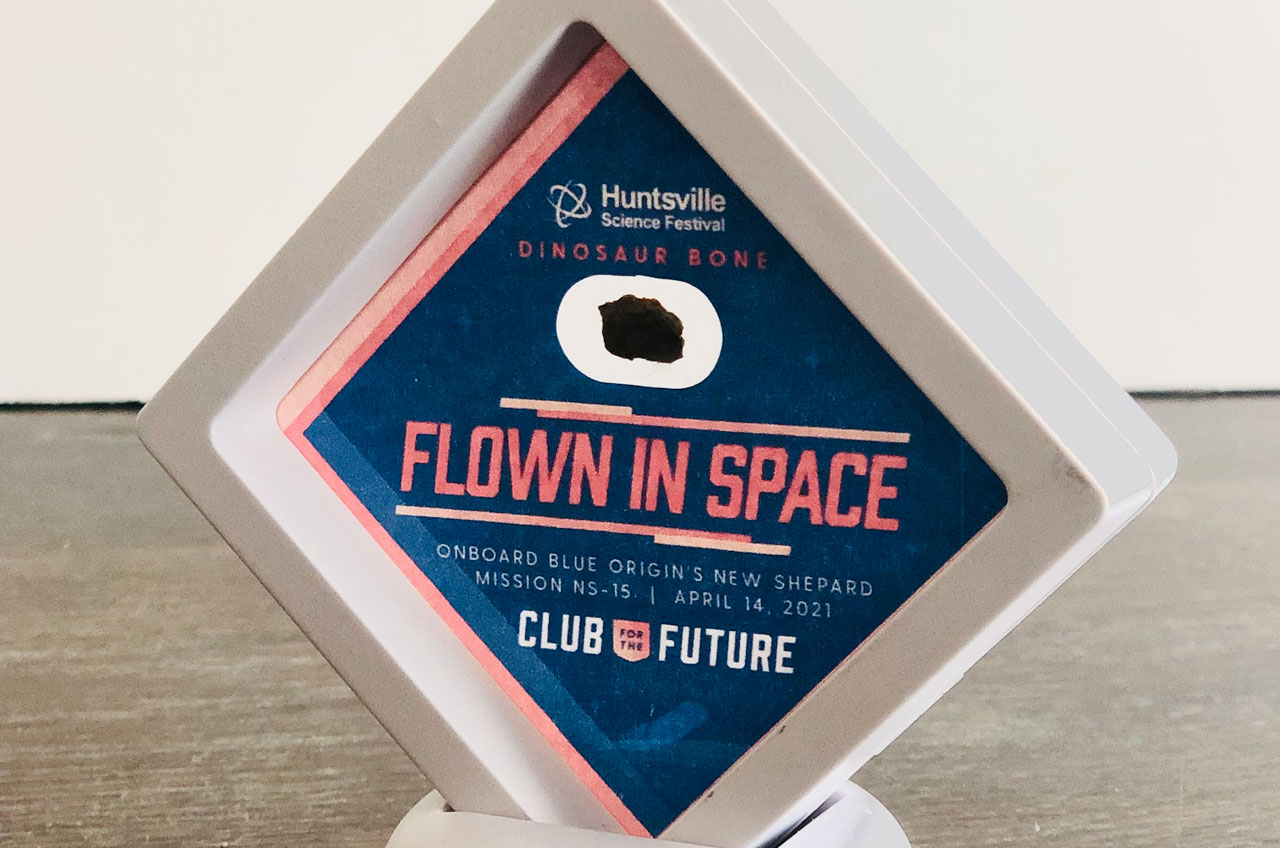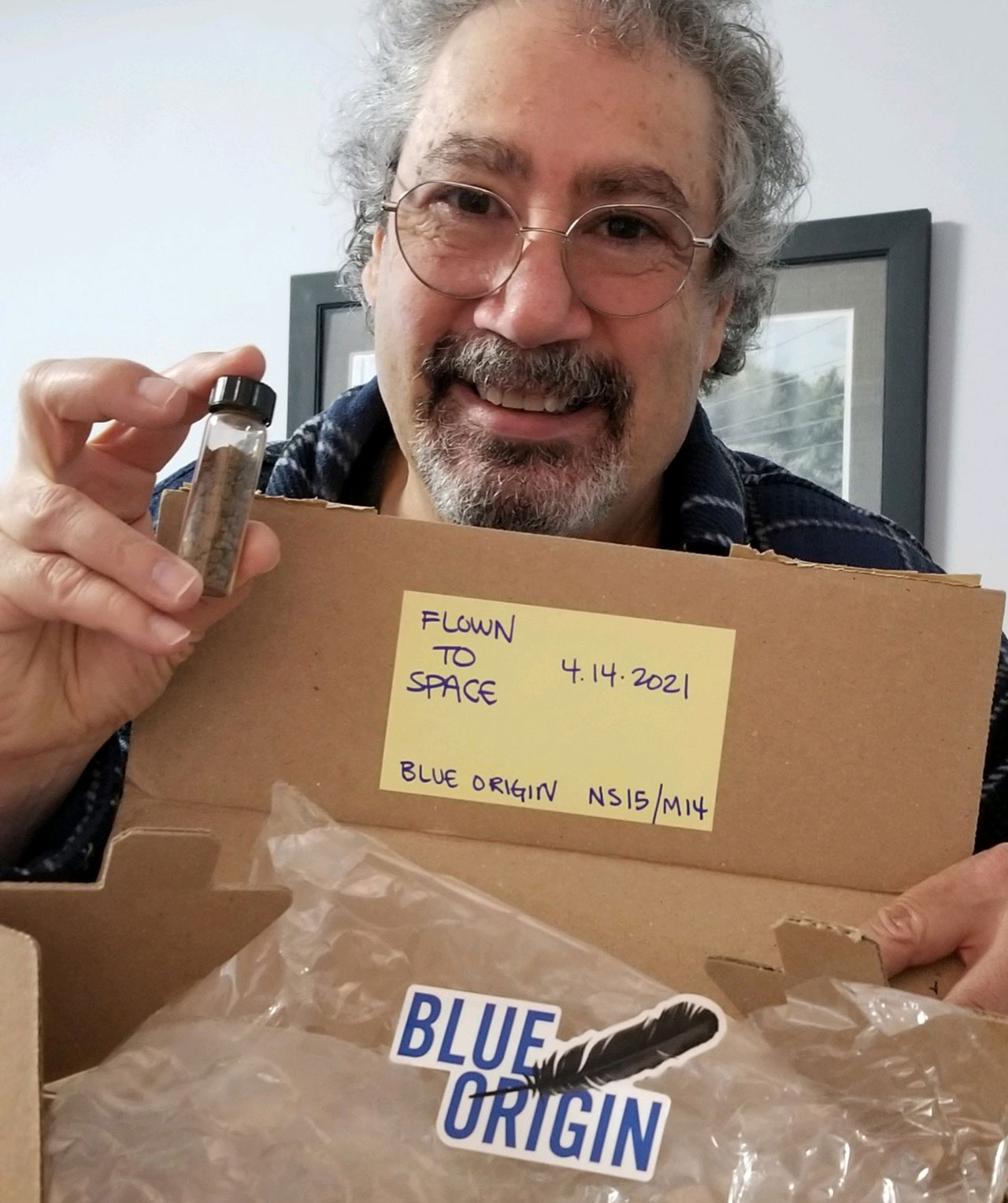Blue Origin launches dinosaur bones into space for 'Dream Big' initiative

Blue Origin has launched pieces of the past for its Club for the Future.
Jeff Bezos' commercial spaceflight company recently sent dinosaur bones into space to support its nonprofit's Dream Big Alabama initiative and the Huntsville Science Festival. The fossil fragments, each 65 to 70 million years old, lifted off in April on the 15th and last test flight before Blue Origin plans to start flying people aboard its New Shepard suborbital launch vehicle.
"The dinosaur bones are from a 'dromaeosaurid' in the raptor family — likely a Dromaeosaurus," Joe Iacuzzo, founder of the Huntsville Science Festival and former editor and content developer for Universal Pictures' Jurassic Park Institute, said in an interview published by the Club for the Future. "The bird-like, feathered carnivorous dinosaurs were about 7 feet [2 meters] long, stood just over two feet [0.6 m] high at the hips and had 'killer claws' on each foot that sliced into its prey when deployed."
Related: How Blue Origin's New Shepard vehicle works (infographic)
The nearly 200 small bone pieces all fit inside a 4-inch (10 centimeters) vial for the flight, which launched them to 65 miles (105 kilometers) above the ground, 3 miles (5 km) above the Kármán Line separating Earth and space. The fossils were aloft for 10 minutes and 10 seconds, packed alongside more than 25,000 postcards for Club for the Future members and "Mannequin Skywalker," a test dummy used to collect data about the passenger experience.
"It seems very appropriate that a member of the raptor family of bird-like feathered dinosaurs would fly on board New Shepard, a rocket that prominently features the Blue Origin feather," said Iacuzzo. "Unfortunately for dinosaurs, it was an asteroid falling from space that helped cause their extinction. Sending this dinosaur up to space seems like a fitting poke-in-the-eye to that asteroid!"
The Dromaeosaurus fossils were found on private land in the Hell Creek formation of South Dakota. Now back from space, they are being individually mounted and presented to members of the Club for the Future and to museums around the country. The displays will also go toward the Huntsville Science Festival, which is scheduled for Oct. 24 to 30.
Get the Space.com Newsletter
Breaking space news, the latest updates on rocket launches, skywatching events and more!
"The bones will be used as tokens of appreciation for partners and supporters of the Huntsville Science Festival, which was founded by Innovation for Education Foundation, a Huntsville-based non-profit, and Dream Big Alabama, a state-wide initiative to give every student direct access to space thanks to Club for the Future and Blue Origin's rockets," said Iacuzzo.
A small number of the flown-to-space dinosaur bones are still available for those interested in sponsoring the festival. Interested parties should contact Iacuzzo for details.

The Dromaeosaurus is not the first dinosaur — or part of a dinosaur — to fly into space. At least two NASA space shuttle missions flew fossils at the request of their crew members.
STS-51F payload specialist Loren Acton launched with a piece of the vertebra and an eggshell from a baby Maiasaura in 1985. The duck-billed dinosaur parts were flown on the space shuttle Challenger for Montana State University, Acton's alma mater and where he later taught physics.
Thirteen years later in 1998, former NASA astronaut Jay Apt, then-director of the Carnegie Museum of Natural History in Pittsburgh, Pennsylvania, arranged for a 210-million-year-old Coelophysis skull to launch on the space shuttle Endeavour. The fossil flew with the STS-89 crew to Russia's space station Mir before returning to Earth.
Part of a Tyrannosaurus rex also flew to space, launching on the first Exploration Flight Test (EFT-1) by NASA's Orion spacecraft in 2014. The fossil from the "king of the tyrant lizards" was loaned by the Denver Museum of Nature and Science in Colorado "as a reminder of how much life Earth has seen during its existence," a NASA statement explained.
Follow collectSPACE.com on Facebook and on Twitter at @collectSPACE. Copyright 2021 collectSPACE.com. All rights reserved.
Join our Space Forums to keep talking space on the latest missions, night sky and more! And if you have a news tip, correction or comment, let us know at: community@space.com.

Robert Pearlman is a space historian, journalist and the founder and editor of collectSPACE.com, a daily news publication and community devoted to space history with a particular focus on how and where space exploration intersects with pop culture. Pearlman is also a contributing writer for Space.com and co-author of "Space Stations: The Art, Science, and Reality of Working in Space” published by Smithsonian Books in 2018.In 2009, he was inducted into the U.S. Space Camp Hall of Fame in Huntsville, Alabama. In 2021, he was honored by the American Astronautical Society with the Ordway Award for Sustained Excellence in Spaceflight History. In 2023, the National Space Club Florida Committee recognized Pearlman with the Kolcum News and Communications Award for excellence in telling the space story along the Space Coast and throughout the world.











